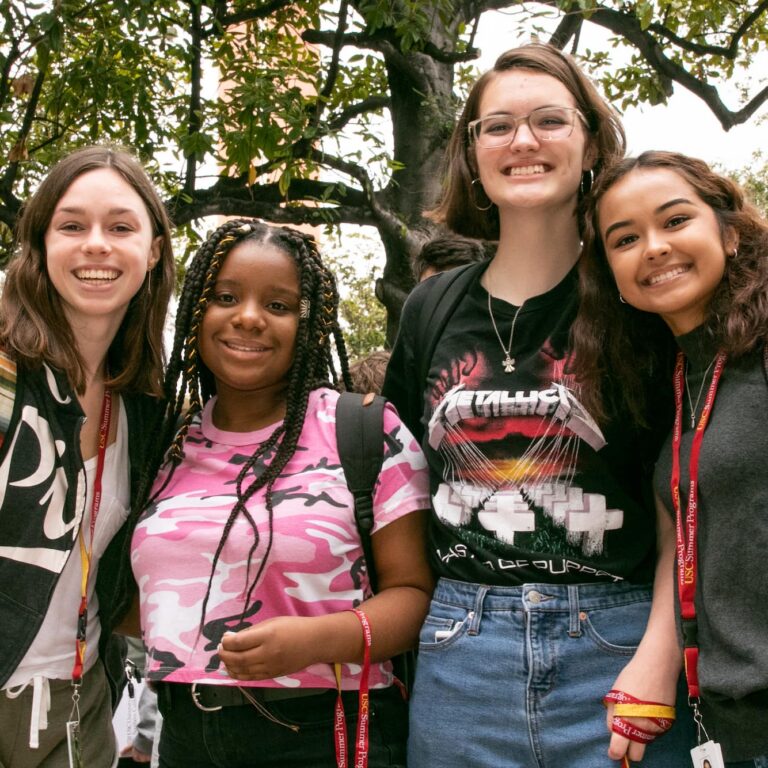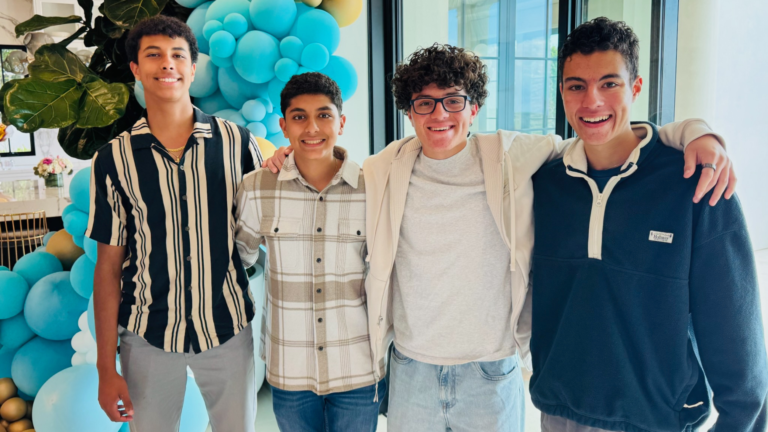
USC Summer Programs students in the “Summer Theatre Conservatory: Acting Intensive” course give a performance on stage. If you’re looking to build your performing arts portfolio for college applications, here’s where to start. (Photo: USC)
How to Build Your Performing Arts Portfolio for College Applications
Want to stand out when applying to performing arts schools? Here’s how to build a portfolio while still in high school.
Performing arts is a notoriously hard field to break into, requiring talent, hard work and perseverance. But becoming a great performer also involves training, which is why art schools are often a wise decision for aspiring actors, musicians, comedians and more.
There, they can learn important methods, refine their technique, gain advice from professionals and network with others in the industry. But how do you even get into art school in the first place?
Along with your college application, a great portfolio with varied experiences, strong references and showcases of talent is what propels many high schoolers into the art school of their dreams. To learn more about what goes into a performing arts portfolio, we spoke with Meghan Laughlin, the director of internships and special programs at the USC School of Dramatic Arts.
Here is everything you need to know about performing arts school admissions and building your portfolio:
What Do Performing Art Schools Require for College Applications?
Applying to a performing arts school differs from applying to a typical Bachelor of Arts or Bachelor of Science program. In addition to submitting an application with your academic transcript, letters of recommendation from teachers, managers or mentors, and a personal essay, you’ll also need to showcase your creative talent. This often includes a resume highlighting your past performances (such as high school plays, dance recitals or theatre groups) and a recorded or live audition, all as part of a comprehensive arts portfolio.
The USC School of Dramatic Arts, for example, requires prospective undergraduate students to fill out the CommonApp as well as submit a performance resume, a headshot, a “Take Two” (described as “two images that will give us some insight into who you are and what is important to you,” per the website), a letter of recommendation from a drama teacher or coach, and a “Who Are You” video that is 90 seconds long “showcasing your personality.”
And that’s just for the Bachelor of Arts in Dramatic Arts. If you’re interested in the Bachelor of Fine Arts in Acting for the Screen and Stage program or the Bachelor of Fine Arts in Musical Theatre, you will be asked to include filmed audition monologues or filmed musical performances.
What Goes Into a Performing Arts Portfolio for a College Application?
If you’re submitting a portfolio for a performing arts school, it should include multiple tapes showing off your abilities (an audition monologue, a dance performance, a musical theatre piece), letters of recommendation from people in the dramatic arts, a current headshot and, of course, a resume highlighting your past performances and all the training you have received so far. This could include your participation in your high school theatre, outside classes or private lessons, and even a pre-college program, like the ones offered by USC, which include the “Acting Intensive,” “Musical Theatre” and “Comedy Performance” courses.
When it comes to advice for creating this kind of portfolio, Laughlin noted to “always … be your unique, authentic self.”
“We want to hear your voice. Whether you are an actor, stage manager, designer, writer … Everyone is valued and has something unique to say and add … [so in the applications] I just want to learn about the student, their background and what excites them in theatre, creativity, their artistic world — what it is they’re drawn to,” she said.
How Does a Pre-College Program Boost Your College Application?
A pre-college program can certainly boost your college application and help you build your portfolio, especially when it comes to the performing arts. These programs usually have high schoolers spend a few weeks living on a college campus (although many universities, including USC, offer commuter options and even online courses), where they immerse themselves in college-level classes in their chosen field of study.
Not only does this help students get acclimated to life on campus and learning on a college level, but it also helps:
Students train in their specific skill set. Theatre program participants, for example, will learn all kinds of useful methods and techniques that make them more prepared for college — and demonstrate to admissions offices they’ve actually picked up those talents.
Students become exposed to other art forms. Program participants can explore musical theatre, comedy or dramatic acting at USC. This gives them the opportunity to discover which types of performances they enjoy most, especially if they haven’t had the chance to try them before.
Students receive valuable feedback to refine their arts portfolios. High school participants work with professionals who offer guidance on selecting programs, applying to art schools and effectively showcasing their talents. Laughlin emphasized that this personalized feedback is a key component of the USC program.
“We also designate time in our program at the end in all the classes where we address the college audition. They have an opportunity to work with faculty. Some of them will even get on their feet and work through a monologue, which again, will prepare them for what that college audition process is going to be like,” she explained.
Students have the opportunity to network with new mentors. These staff members not only provide advice to help students improve as performers and strengthen their applications, but they can also write letters of recommendation that enhance an arts portfolio.
Simply put, pre-college programs offer an engaging and valuable way to gain the experience and mentorship needed to make a performing arts portfolio stand out. They also give high schoolers the exposure they need to decide if a career in the arts is right for them.
“Just having the opportunity to immerse yourself is great. It means you go into the application prepared and knowing what you are submitting for,” Laughlin said. “There’s so much value in giving yourself a test run before you enter any program.”
What Are the Benefits of USC Pre-College Programs?
According to Laughlin, USC’s pre-college programs offer all the benefits mentioned above — professional training, resume enhancement, mentorship, and exposure to college life — but there are several aspects that make them stand out from the competition.
She explained that, overall, the programs truly prepare students for what they can expect if they choose to pursue an undergraduate or master’s degree at USC.
“I always tell students in admissions, not all theatre programs are created alike. Every institution is different in what they offer. In our pre-college program, we give students a taste of what it would be like to be in our BFA programs, which are conservatory style, but also have GEs. They have the opportunity over the four weeks to really immerse themselves in that topic and get a sense of what it’s like to be here,” she said
“Here” is a key word, Laughlin emphasized, as USC’s campus is located in Los Angeles — widely regarded as the premier destination for the performing arts in the U.S.
“We leverage our location in Los Angeles, a global capital for the entertainment industries. We want to give a taste of the arts and industry in LA to the high school students who come to our pre-college program. They’ll go on field trips to see local theatre, to performances, to studio tours. Those in the comedy class go out and do open mic nights, things you can’t do at other schools,” she said.
Another advantage of being at a school in LA, Laughlin noted, is that it attracts faculty who are seasoned professionals with extensive industry connections. This provides students with access to a wide range of shows and the possibility to network with those in the field.
“Where we are located geographically, it just means we can attract really top-level, at-the-height-of-their-craft instructors,” she said.
Ultimately, it’s an incredible place for high schoolers to either test out or hone their love of the performance arts, Laughlin emphasized. The students’ reactions at the end of the four-week program speak for themselves.
“It’s overwhelmingly positive,” she said.
Learn more about USC Pre-College Programs today.



